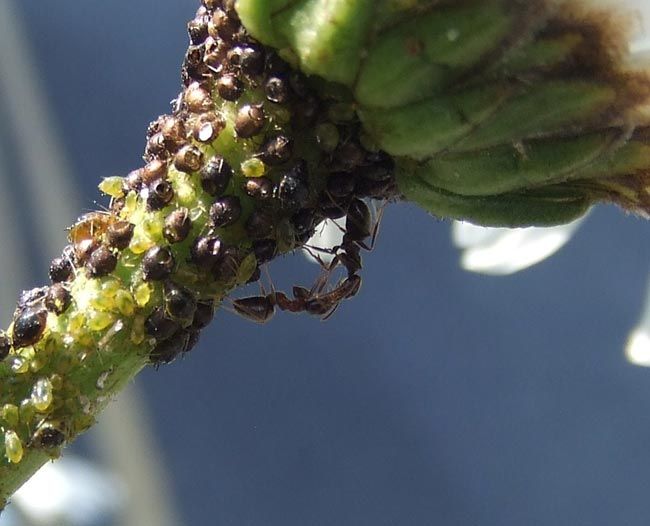Ants Corral and Tranquilize Victims

Hungry ants corral aphids into nearby food-producing herds by rounding them up and penning them in with trails of chemical footprints they leave behind, a new study finds.
The result is "honeydew on tap," researchers say.
Scientists have known that ants tend to hang out near colonies of certain types of aphids that produce a sugar-rich, sticky honeydew when they munch on plants. Because the sugary substance is a staple of the ant diet, the ants use many means to manipulate the aphid populations for their own use.
Previous studies have shown that ants will bite off the wings of aphids to keep them from flying away and that certain chemicals produced in the glands of ants can sabotage the growth of aphid wings. But the new study showed that ants will also leave chemical traces when they walk to 'tranquilize' the aphids and keep them close by.
To pin down this ant behavior, a team of British scientists used a digital camera and special software to measure the walking speed of aphids when they were placed on filter paper that had previously been walked over by ants. They found that the aphids moved much slower on the paper with the ant footprints than they did on plain paper.
Researchers also placed the aphids on dead leaves, which they instinctively walk off of in search of healthy leaves to eat, and found that the presence of ants significantly slowed the aphids' travels, which could work to the ants' benefit.
“We believe that ants could use the tranquilizing chemicals in their footprints to maintain a populous ‘farm’ of aphids close to their colony, to provide honeydew on tap," said study leader Tom Oliver of the Imperial College London. "Ants have even been known to occasionally eat some of the aphids themselves, so subduing them in this way is obviously a great way to keep renewable honeydew and prey easily available.”
Sign up for the Live Science daily newsletter now
Get the world’s most fascinating discoveries delivered straight to your inbox.
The relationship may work out to the aphids' benefit in some ways though, Oliver points out.
"Ants have been documented attacking and fighting off ladybirds and other predators that have tried to eat their aphids," he said. "It’s possible that the aphids are using this chemical footprint as a way of staying within the protection of the ants.”
But ultimately the research, detailed in the Oct. 10 issue of the journal Proceedings of the Royal Society B: Biological Sciences, shows that aphids are being "farmed" as a steady food source, which is more to their disadvantage, Oliver added.
“Although both parties benefit from the interaction, this research shows that all is not well in the world of aphids and ants," Oliver said. "The aphids are manipulated to their disadvantage: for aphids the ants are a dangerous liaison.”
- Top 10 Insect Secret Weapons
- Why Ants Rule the World
- Images: Backyard Bugs

Andrea Thompson is an associate editor at Scientific American, where she covers sustainability, energy and the environment. Prior to that, she was a senior writer covering climate science at Climate Central and a reporter and editor at Live Science, where she primarily covered Earth science and the environment. She holds a graduate degree in science health and environmental reporting from New York University, as well as a bachelor of science and and masters of science in atmospheric chemistry from the Georgia Institute of Technology.










